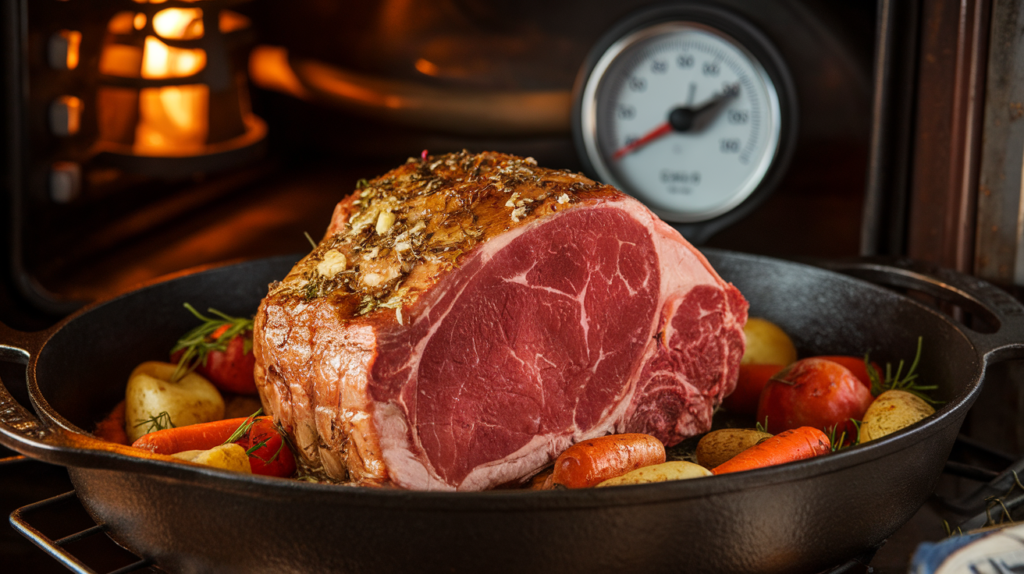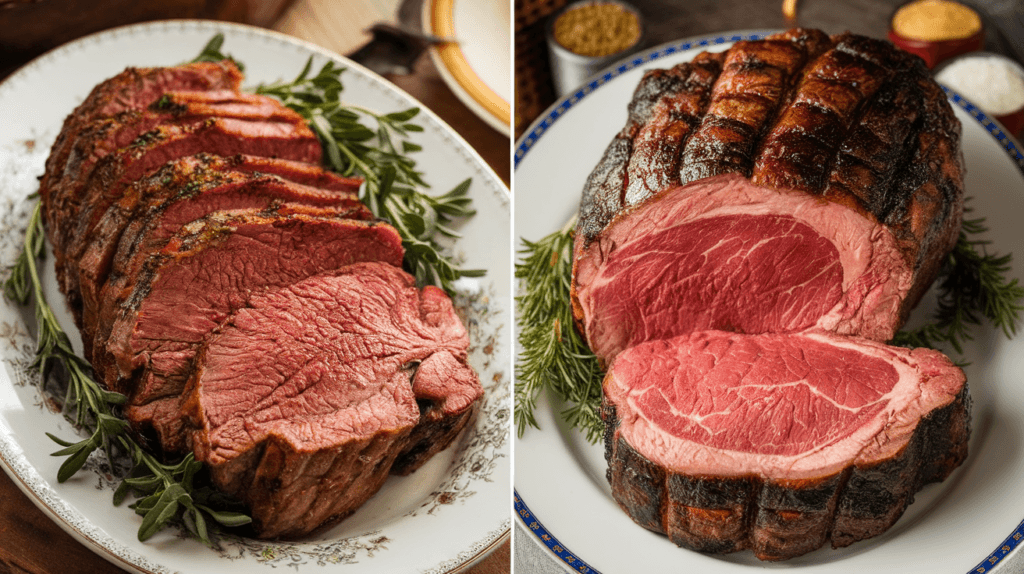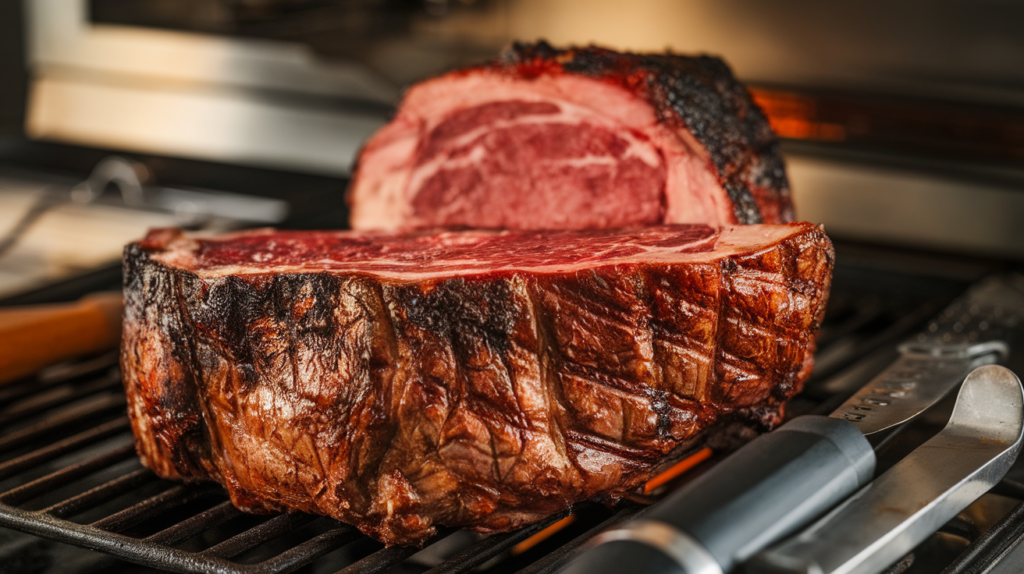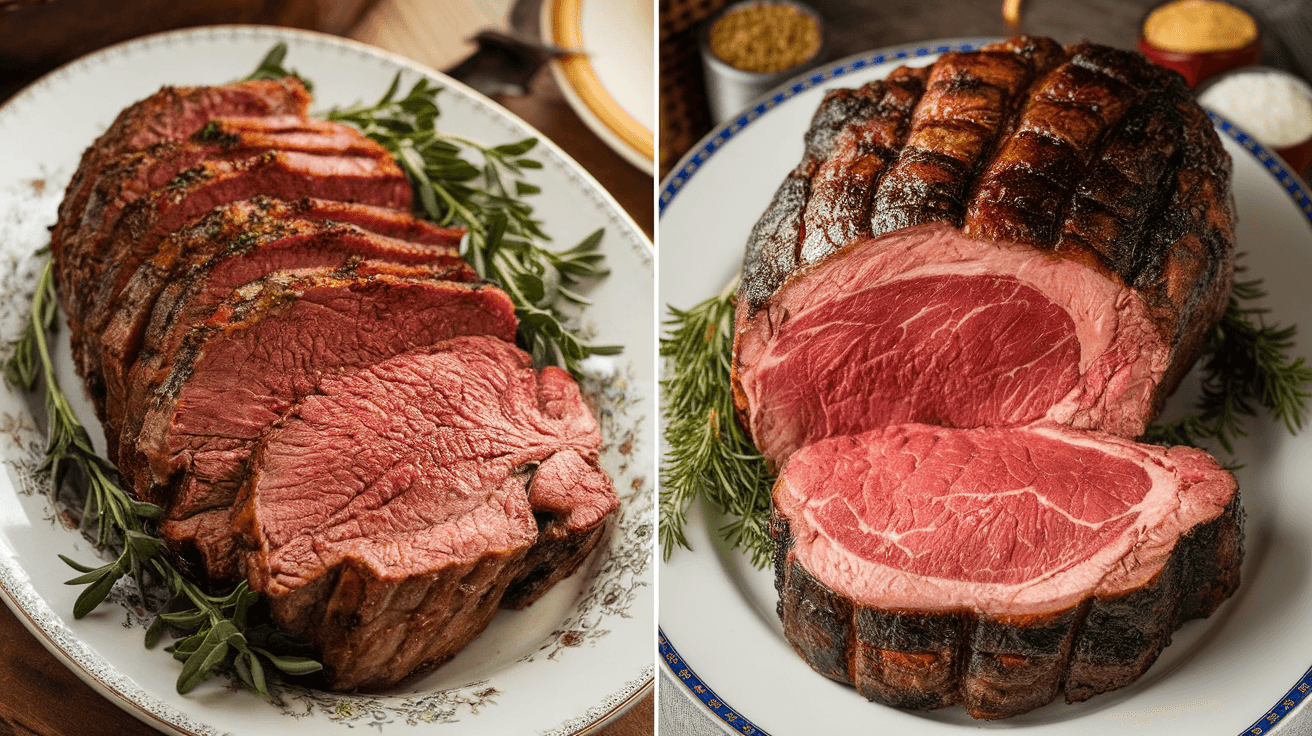Introduction
Prime rib, a succulent and flavorful cut of beef, is often the centerpiece of festive gatherings and special occasions. Its rich marbling and tender texture make it a favorite among meat lovers. But when it comes to cooking, many ask: Is it better to cook prime rib slow or fast? This debate sparks interest among culinary enthusiasts, as both slow and fast methods can produce stunning results. Understanding whether it’s better to cook prime rib slow or fast is key to achieving the perfect flavor and texture. So, is it better to cook prime rib slow or fast? Let’s explore both techniques in detail.
This article explores the pros and cons of slow and fast cooking methods for prime rib. From flavor and texture to crust formation and juiciness, we’ll dive deep into the details so you can make the best choice for your next culinary adventure.
Understanding Prime Rib Cooking Methods
Slow Cooking vs. Fast Cooking Techniques
When it comes to preparing prime rib, the cooking technique significantly impacts the final result. Slow cooking and fast cooking are the two primary methods used by chefs and home cooks alike. Each technique offers distinct benefits and challenges, making it important to understand their differences.
Slow cooking involves using low temperatures over an extended period. This method allows the meat to cook evenly, ensuring a tender and juicy center. The gradual heat breaks down connective tissues, enhancing the overall texture and flavor.
On the other hand, fast cooking relies on high heat for a shorter duration. This technique is often used to create a flavorful crust quickly. While it can lock in moisture, it requires careful attention to avoid overcooking the interior of the meat.
Deciding between these methods depends on your goals, available time, and personal preference. Let’s explore each technique further to determine which is best suited for cooking prime rib.
The Science of Slow Cooking Prime Rib
Why Slow Cooking Enhances Flavor and Texture

Slow cooking prime rib is a favored method for achieving perfectly cooked meat. This approach allows the meat to gradually reach its desired temperature, ensuring even heat distribution and preventing overcooking. Many wonder, is it better to cook prime rib slow or fast, and slow cooking stands out for delivering a consistent texture throughout the roast. The slow process also gives the connective tissues time to break down, creating a buttery, tender bite that melts in your mouth. For those debating whether it’s better to cook prime rib slow or fast, the benefits of slow cooking are clear.
Furthermore, slow cooking amplifies flavor. The extended cooking time helps the seasoning penetrate deeper into the meat. This process is especially effective when the prime rib is marinated or coated with a flavorful rub before cooking.
Best Temperatures for Slow Cooking
To achieve perfect results, maintaining the right temperature is crucial. For slow cooking, set your oven to a temperature between 225°F and 250°F. This low heat ensures the meat cooks gently and evenly. Using a meat thermometer is essential to monitor the internal temperature, ensuring the prime rib reaches the desired level of doneness.
Here’s a quick guide to internal temperatures for prime rib:
- Rare: 120°F – 125°F
- Medium Rare: 130°F – 135°F
- Medium: 140°F – 145°F
By slow cooking your prime rib, you not only enhance its natural flavors but also achieve the tenderness and juiciness that make this cut of meat so exceptional.
Understanding Prime Rib Cooking Methods
Slow Cooking vs. Fast Cooking Techniques
Cooking prime rib is an art that relies heavily on the method chosen. The two primary approaches—slow cooking and fast cooking—each offer distinct results. Let’s explore what these techniques entail:
Slow Cooking
Slow cooking involves roasting the prime rib at a lower temperature, typically between 200°F and 275°F (93°C to 135°C). This method requires patience, as the cooking time can stretch to several hours depending on the size of the roast. Slow cooking ensures an even temperature throughout the cut, which helps in achieving a tender and flavorful result.
Fast Cooking
Fast cooking, also known as high-heat roasting, involves using higher temperatures, typically 400°F to 500°F (204°C to 260°C). This method rapidly sears the outer layer of the prime rib, creating a crispy crust, and significantly reduces cooking time. However, it requires careful monitoring to prevent overcooking.
Each technique has its unique advantages, and the choice often depends on factors such as the desired texture, flavor, and the time available for preparation.
Comparative Analysis: Slow vs. Fast

Which Method is Better for Seasoning Penetration?
When it comes to seasoning, slow cooking has a distinct advantage. The extended cooking time allows herbs, spices, and marinades to seep deeper into the meat, resulting in a more robust and consistent flavor profile. This method is especially beneficial if you’ve marinated the prime rib overnight.
On the other hand, fast cooking primarily enhances the outer layer of the prime rib, creating a flavorful crust. While this provides an immediate burst of flavor, the seasoning may not penetrate as deeply compared to slow cooking.
The Impact on Crust Formation
For those who love a crisp, caramelized crust, fast cooking is the clear winner. The intense heat quickly forms a beautiful golden-brown exterior, enhancing the overall texture and appearance of the prime rib. However, slow cooking can achieve a similar effect by briefly finishing the roast at high heat, known as reverse searing.
Ultimately, the choice between slow and fast cooking often depends on your priorities: Do you value deep seasoning and tender texture, or is a crunchy crust and speed more important?
How to Cook Prime Rib Perfectly
Step-by-Step Guide to Slow Cooking
1. Preheat your oven to 225°F (107°C).
2. Season the prime rib generously with salt, pepper, garlic, and your preferred herbs.
3. Place the roast on a rack in a roasting pan.
4. Insert a meat thermometer into the thickest part of the meat.
5. Cook until the internal temperature reaches 130°F (54°C) for medium-rare.
6. Let the roast rest for 20 minutes before slicing and serving.
Step-by-Step Guide to Fast Cooking
1. Preheat your oven to 450°F (232°C).
2. Season the prime rib with a flavorful rub or marinade.
3. Place the roast in a hot oven and cook for 15–20 minutes.
4. Lower the heat to 325°F (163°C) and cook until the internal temperature reaches your desired doneness.
5. Let the meat rest for 15–20 minutes before slicing to preserve the juices.
The Advantages of Cooking Prime Rib Fast

Time-Saving Benefits
Fast cooking, often referred to as high-heat roasting, is an excellent option for those who are short on time but still want a delicious prime rib. This method significantly reduces cooking time by searing the meat at high temperatures, usually between 400°F and 500°F (204°C to 260°C). For smaller cuts of prime rib, this can mean having a perfectly roasted dish ready in under an hour.
The quicker cooking process is particularly advantageous for last-minute preparations, busy schedules, or when you need to prepare multiple dishes for a single event. The high heat creates a beautiful crust on the exterior of the meat, locking in juices and enhancing the visual appeal of the dish.
Does Fast Cooking Retain Juiciness?
One of the common concerns about fast cooking is whether it can retain the juiciness of the meat. While this method creates a crisp and flavorful crust, the rapid exposure to high heat can sometimes lead to uneven cooking, particularly in larger cuts. The outer layers may become overcooked while the center remains underdone.
However, careful temperature monitoring and precise timing can help mitigate this issue. Using a meat thermometer and resting the meat after cooking are key steps to ensure the juices redistribute evenly, resulting in a tender and juicy roast.
For those who enjoy a pronounced crust and don’t mind a slightly less tender texture in exchange for faster preparation, the fast-cooking method is a viable option.
Expert Opinions on Cooking Prime Rib
What Chefs Say About Slow Cooking
Many professional chefs advocate for slow cooking prime rib because of its ability to enhance the meat’s natural flavors and tenderness. Renowned culinary experts emphasize that slow cooking allows for precise control over the internal temperature, making it easier to achieve perfect doneness.
Chef Gordon Ramsay, for example, suggests that slow cooking is ideal for large cuts, as it prevents overcooking while ensuring the interior remains juicy. By maintaining a consistent low temperature, you can achieve a restaurant-quality result with minimal risk.
Professional Tips for Fast Cooking
While slow cooking is often preferred for its reliability, many chefs acknowledge the benefits of fast cooking in certain scenarios. High-heat roasting is recommended when time is limited, as it delivers a beautifully caramelized crust. According to culinary experts, a preheated oven at 450°F to 500°F (232°C to 260°C) is crucial for achieving that coveted crispy exterior.
Chef Thomas Keller advises that if you opt for fast cooking, it’s essential to monitor the meat closely and use a meat thermometer. The high heat can overcook the roast quickly if you’re not attentive. He also suggests resting the prime rib properly to retain juices, even when cooking quickly.
Balancing Both Techniques
Some chefs combine slow and fast cooking for the best results. They recommend slow roasting the prime rib until it reaches just below the desired doneness, then finishing it with a high-heat blast to form a golden, flavorful crust. This hybrid approach ensures a tender interior and a crisp, flavorful exterior, marrying the advantages of both methods.
Frequently Asked Questions (FAQ)
What is the best method for cooking prime rib: slow or fast?
The best method depends on your goals. If you want tender, evenly cooked meat with enhanced flavor, slow cooking is ideal. For a crispy crust and a shorter cooking time, fast cooking is better. Many chefs recommend combining both techniques for optimal results.
Can you combine slow and fast cooking methods?
Yes, combining the two methods can produce excellent results. Start by slow roasting the prime rib at a low temperature until it is nearly done, then finish with a high-heat sear to create a crispy crust.
What temperature should I aim for when cooking prime rib?
The ideal internal temperature depends on your preferred doneness. For medium-rare, aim for 130°F (54°C), and for medium, aim for 140°F (60°C). Always use a meat thermometer to ensure accuracy.
How long should I let the prime rib rest after cooking?
Letting the prime rib rest for 20–30 minutes after cooking is essential. Resting allows the juices to redistribute, ensuring the meat is moist and flavorful.
Why is slow cooking preferred for large cuts of prime rib?
Slow cooking ensures even heat distribution, which is particularly important for larger cuts. It helps avoid overcooking the outer layer while the center reaches the desired doneness.
Should I cover the prime rib while it cooks?
It depends on the method. For slow cooking, covering can help retain moisture. For fast cooking, leaving the roast uncovered promotes a crispy crust.
Conclusion
When deciding whether to cook prime rib slow or fast, it ultimately comes down to your preferences, the time you have available, and the results you want to achieve. Slow cooking is ideal for achieving tender, flavorful, and evenly cooked meat, while fast cooking delivers a crispy crust and saves time.
For the best of both worlds, consider combining the two methods. Start with slow roasting to cook the meat gently and finish with a high-heat sear to lock in juices and create a perfect crust. Always use a reliable meat thermometer and let the roast rest after cooking for optimal results.
Whether you choose slow or fast cooking, prime rib is a show-stopping centerpiece that, when prepared thoughtfully, will leave your guests impressed and satisfied. Experiment with these methods to find the approach that works best for you, and enjoy the culinary journey!

